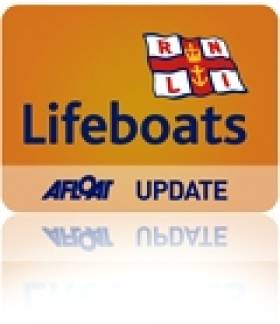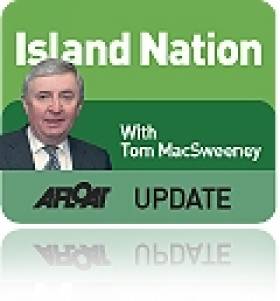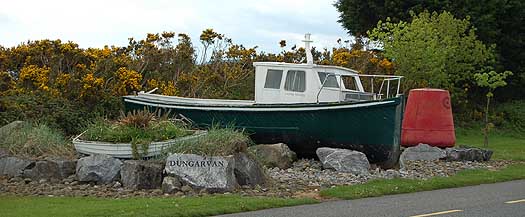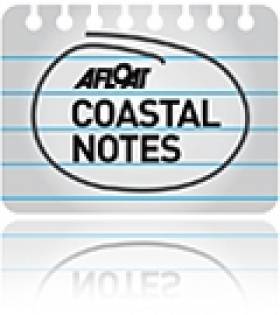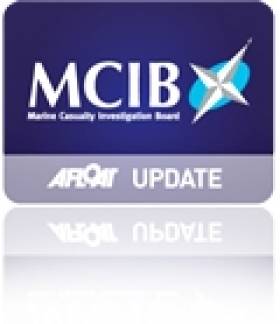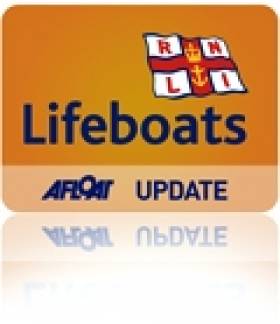Displaying items by tag: Dunmore East
#RNLI - The Dunmore East RNLI lifeboat launched yesterday (Tuesday 10 June) to assist a yacht that fouled its propeller on a mooring on the northern side of Cheekpoint in the Waterford Estuary.
At lunchtime the Irish Coast Guard's Marine Rescue Co-ordination Centre in Dublin requested Dunmore East RNLI to launch to assist the French couple on board the yacht.
Shortly after launch, the Trent class lifeboat Elizabeth and Ronald arrived on scene and transferred one of its volunteer lifeboat crew on board the casualty vessel, where he managed to free the yacht from the mooring.
As the propeller was still fouled, and with the vessel in close proximity to a busy shipping lane and a strong run of tide, it was decided to take the yacht under tow.
Shortly before 5pm the yacht was brought into the safety of Dunmore East Harbour.
Dunmore East RNLI coxswain Paulie Daniels said after the callout: “The couple were lucky that although they were just inside a busy shipping channel, the weather conditions at the time were good and they were wearing lifejackets."
#islandnation – The 'reach' of friendship which sailing has was demonstrated to me when I was trying to record kittiwakes who live on the cliff face in Dunmore East. The County Waterford fishing port has a colony of the black-legged birds which is unique.
I had actually gone there to see the new leisure marine facilities opened by the Minister for the Marine, Simon Coveney, who said his Department has spent €450,000 on them and to get reaction to his announcement that the long-awaited dredging of the port, which has been on hold for many years, would be going ahead. It will cost about €4m and is badly-needed by the local fishing fleet. Quite a bit of the harbour has silted up over the years.
(See also WM Nixon's blogs: Dunmore East: A Suitable Harbour for a Marina? and Could Dunmore East's Development Be Key to Ireland's Cruising Success? – Ed)
I was driving past the kittiwakes, stopped to have a look and heard their distinctive cry. I have recorded a lot of different sound effects during my time as a radio reporter, but it took a lot of effort to record those black-legged kittiwakes high up over the roadway. They are a small oceanic bird which breeds in the Northern Hemisphere from Portugal to the low Arctic zones. Their distinctive call sounds like "kitt-ee-wayke". What is unique about them in the inner harbour in Dunmore East is that their colony is unique in Ireland for its proximity to humans.
It took the best part of an hour to get 30/40 usable seconds of sounds and I had just finished when the crew from Waterford Harbour's Sigma 33 OOD, Flyover, owned by David Marchant, asked me what I was doing. They had just brought it back from Kinsale, where they had been racing in that South Cork club's Spring series. I spent a pleasant half-an-hour discussing the sailing ability of Sigmas. They sailed Flyover very well and took a few prizes out of Kinsale.
They also took her to Cork for the RCYC's Autumn series last year, where they also did well.
If you want to hear how the kittiwakes sounded on my radio programme, click THIS ISLAND NATION link.
I understand now why and how it takes so much time and effort to make Nature programmes!
PEOPLE OF THE SEA – OR ARE WE ?
The new slipway for leisure craft in Dunmore alongside the harbour's sailing club is welcome. I also stopped for a while at the memorial to lost seafarers in the village. It is an impressive monument and I found it an emotional and salutary experience to read the names on the memorial and realise how many have died in maritime tragedies around this part of the coastline.
The lost seafarers monument in Dunmore East
That led me to play on my radio programme, 'SEA PEOPLE,' a song performed by a choir composed of the people of another fishing community - the fishermen and women of Newfoundland & Labrador. Calling themselves 'Folk of the Sea,' they formed their group to highlight the importance of fishing tradition after their community suffered from the collapse of the cod fishery. They are sea people and so are we, the Irish. Forty per cent of the population of Ireland lives in coastal and rural communities. Ireland's cities are all located close to the coast. Half of Ireland's population lives within 10 kilometres of the coastline.
But political commitment to the marine sphere is still lacking. While Taoiseach Enda Kenny extolled what his Government intends to achieve when speaking at the naming ceremony of the new Naval vessel, the L.E.Samuel Beckett in Dublin last Saturday, he has not acted in regard to the effective work of the Oireachtas Committee Report on Coastal and Island Communities. It delivered it report to the Dáil last January after a year's work, containing realistic proposals about the future of these communities. The Committee called for a Dáil debate on their report and recommendations.
Five months later there has been no positive response from the Government. When I asked the Taoiseach's Department why he had not responded to the Committee's request, his PR people told me to ask the Chairman of the Committee. He is a Fine Gael TD and has not been given an explanation!
REMOVING FISH DISCARDS COULD DAMAGE SEABIRDS AND MARINE LIFE
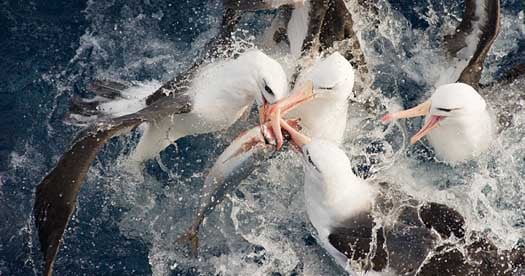
Discards are food to seabirds
Referring back to sea birds, the EU decision to end the practice of discards, by which fishermen dumped catches overboard because they could not land it ashore because of fear of prosecution for quota infringements, could be harmful to bird life and fish species rather than a benefit. That view has been expressed by a Scottish Professor, Mike Heath of the University of Strathclyde.
He says that wildlife everywhere capitalise on waste from human activity and feed on discarded fish. That includes seabirds, marine mammals, seabed animals and other fish. "Banning discards of fish could have unintended effects on the ecosystem," he warns.
NAVAL SHIP NAMES NOT POPULAR
The Government's decision to name the two new Naval ships after Samuel Beckett and James Joyce, ending the tradition of vessels called after female Celtic mythological figures, is not universally popular either within or outside the Naval Service. Serving personnel are not permitted to speak publicly, but several have privately expressed disagreement. Former Naval officers have voiced disgust. Former Minister for Defence and Justice, Alan Shatter, has been described as forcing the change through. Taoiseach Enda Kenny named the first of the new ships the Samuel Beckett on Saturday in Dublin, noticeably not at the Naval Base in Haulbowline in Cork Harbour. He avoided referring to the naming controversy. Ending tradition is never without challenge, but this decision has not been well received.
BIGGEST ICE CLEARANCE IN 35 YEARS
The Great Lakes between the USA and Canada are huge inland. The US Coast Guard this week said the past Winter season had produced "the thickest and most expansive ice cover in 35 years." It released statistics at the end of Operation Taconite, the biggest ice clearance operation to keep shipping moving on the Great Lakes "through one of the most brutal winters on record."
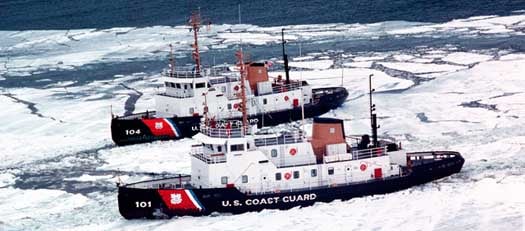
US Icebreakers clearing ice for ships on the Great Lakes
Besides various liquid and dry cargoes, vast amounts of iron ore from the northern shores of Lake Superior were carried to steel mills in Lake Erie and Lake Michigan in convoys supported by Coast Guard icebreakers which operated for 160 days. They cleared ice for 946 vessel movements carrying 33 million tons of cargo that had a commercial value of $1.2 billion. This kept industrial production and power generation going in the Great Lakes Region during the winter months.
NORWEGIAN OIL ROW
An environmental and political row has broken out in Norway over the country's biggest offshore oil find since 1974, an estimated resource of 2.9 billion barrels. Opposition parties in an alliance holding the Parliamentary majority wants the Government to make the oil companies use electricity from land to power their offshore oil platforms to reduce greenhouse gases. State oil company, Statoil and its partners in the new Sverdrup find say this will delay "the biggest offshore development in decades." Platforms use gas turbines which account for 25 per cent of Norwegian emissions.
REAWAKENING INTEREST IN GLANDORE
Three South Coast clubs are making a determined effort to revive interest in Glandore Regatta which will be held on the June Bank Holiday Weekend. As Afloat.ie previously reported, Kinsale and the Royal Cork at Crosshaven are joining with Glandore Harbour in a combined effort to get more boats to sail to the West Cork harbour for the event.
"It has been many years since this regatta has had the south coast fleets invade their shores," say the clubs. Kinsale YC yachts will race from their port on Friday, May 29, rounding the Fastnet Rock to finish in Glandore. This replaces the annual Castletownshend. There will be another race from Kinsale direct to Glandore on the Saturday. That day RCYC boats will start from Weaver's Point at Crosshaven at 0855 to race to Glandore. On the Sunday there will be a 1055 first gun for a race from Glandore to Kinsale.
DUNGARVAN PONTOON DEVELOPMENT
Dungarvan Harbour Sailing Club in County Waterford has a new pontoon which can berth 30 boats. It replaces an older structure which had been in place since the early 1990s. This club has a history going back to 1946. The 16-foot 'Petrel' dinghy is the boat which got dinghy sailing established in this south-east club, the first of these being built from designs in an American sailing magazine in 1958. While this was a local boat, club members acquired GP14s for inter-club racing and the club fleet now includes Wayfarers, Lasers, Mirrors and Toppers. Its cruiser fleet has expanded.
A maritime welcome to Dungarvan in County Waterford where a new pontoon has been installed for visiting boats
Depth limitations in the harbour have made bilge-keelers popular. Though dredging was not possible for the new pontoon, future plans are for a more extensive marina. The new facility will provide short-term berthing for Club members as well as access for visiting boats.
• THIS ISLAND NATION, the hour-long maritime programme can be heard on the Afloat website by clicking this link
• Twitter: @TomMacSweeney and @Afloatmagazine
#dunmoreeast – The Minister for Agriculture, Food and the Marine, Simon Coveney TD, today announced details of a €4m dredging project at Dunmore East Fishery Harbour Centre on the occasion of the official opening of a €450,000 renovation of the Marine Leisure Area at the western end of the harbour.
At the opening, the Minister said "I am delighted to officially open this. The completion of this project adds greatly to the Harbour for marine activities generally. This end of the Harbour was in need of revamping for some time, and I prioritised works to make it a fit for purpose amenity which will benefit and promote the marine leisure industry in this area".
Leisure activity in Dunmore East has been increasing substantially in recent years with 180 visiting yachts from all over Ireland and abroad using the harbour in 2013, more than a threefold increase on previous years. Cruise line passengers nearly doubled in 2013 to 9,500 and with the newly renovated slipway it is expected that usage by members of the public will double in 2014 from around 600 in 2013.
The €450,000 renovation included extending the existing slipway, widening it from five to twelve metres, resurfacing and generally improving vehicle and pedestrian access, the development of a promenade with street lighting, improved access to the beach, and a rock armour embankment to protect the development from severe weather conditions.
Commenting on the works the Minister said "This is an excellent piece of infrastructure and is now a top class amenity which will lend itself to the further development of the leisure industry in Dunmore East, and the spin off that will have for tourism and jobs locally".
Announcing the €4m dredging project for Dunmore East to resolve the impacts of years of siltation in the harbour, which has restricted vessel traffic and made manoeuvrability and fish landings problematic for fishermen the Minister said "This significant investment in Dunmore East from the 2014 Fishery Harbour Capital Programme is an indication of this Government's commitment to the fishing industry in the South East. When complete, not only will the harbour be more accessible to larger vessels, landing times and management will be much improved as will the usability of the syncrolift".
Latest figures indicate that the value and volume of fish landings in Dunmore East has been on the increase for a number of years. Between 2010 and 2013 landings increased by 40% from 8,387 tonnes to an estimated 11,718 tonnes. The equivalent value of these landings went from €13.7m in 2010 to an estimated €17.5m in 2013 an increase of 28%.
The Minister went on to say "Taking account of the increased level of fish landings I am conscious of the need to dovetail the much needed dredging works with the seasonal work patterns of the fishing industry to cause as little disruption as possible. With that in mind every effort will be made to ensure that the works will be completed in advance of the important herring fishery later in the year".
Groundwork for the project is well advanced; a public procurement exercise will be initiated in May, with a view to awarding the contract in time for an August commencement date.
Concluding the Minister said "The development and upkeep of Dunmore East as a state of the art Fishery Harbour Centre, supporting a broad range of marine related activities is and will remain an ongoing process. These two major projects and the recent installation of floating pontoons within the Harbour are part of a long term strategy to deliver on the potential of Dunmore East for job creation for the fishing industry and as a marine leisure and tourist destination".
#DunmoreEast - Marine Minister Simon Coveney is set to attend the opening of Dunmore East's new harbour slipway this coming Wednesday 30 April.
The minister will visit the harbour area between 5pm and 6pm to open the slipway as well as announce the dredging of the harbour - funded under the State's €23m package for marine infrastructure repairs announced last month - and the commencement of works on a new harbour building.
Following the harbour visit, the first session of a two-day seminar on 'Empowering Coastal Communities' will take place at the Haven Hotel, with a keynote from Seán Kelly MEP and much interest among the local sailing community.
The seminar, hosted by the Waterford Estuary Communities Network, will continue on 1 May with sessions in Waterford and Hook Head featuring speakers such Afloat's own Tom McSweeney.
WM Nixon has more on the ambitious plans for the Waterford sailing and fisheries hub in his most recent Sailing Saturday column HERE.
Call For Mandatory Smoke Detection On Smaller Fishing Vessels After Kingfisher Fire
#MCIB - The absence of a smoke detection system meant there was no chance for the two-man crew of a Waterford fishing boat to extinguish a fire that engulfed its engine room in an incident off Dunmore East in November 2012.
And marine investigators have urged the Minister for Transport to make such systems a mandatory requirement for all small fishing vessels, according to their official report on the FV Kingfisher.
As previously reported on Afloat.ie, the skipper and crew of the Kingfisher were rescued on the morning of 25 November 2012 after abandoning the vessel to a liferaft.
The Kingfisher had been pair trawling for herring some five miles off Dunmore East with partner vessel FV Mystical Rose when the skipper noticed smoke coming from the exhaust pipe housing on deck.
On opening the engine room hatch, the wheelhouse was quickly engulfed in thick acrid smoke - indicating an oil-based fire - that prevented skipper or crew from making any attempt to put out the fire or even raise the alarm by VHF radio.
Both men on board were retrieved from their liferaft by the Mystical Rose as the Dunmore East lifeboat attempted to extinguish the blaze, with assistance by the Irish Coast Guard helicopter Rescue 117, but to no avail.
In its report, the Marine Casualty Investigation Board (MCIB) determined that the fire was likely too far advanced at the point of discovery to be suppressed by the vessel's sprinkler system or any other means at hand.
The report also noted, importantly, that smoke detection systems are not mandatory for vessels of the Kingfisher's size (less than 15 metres), nor are such boats' bulkheads, deckheads or piping stems required to have any fire-resistant properties.
The MCIB has recommended that the Minister for Transport amend the current Code of Practice for the Design, Construction and Equipment of Small Fishing Vessels of less than 15m Length overall. The full report is available to download below.
Fisherman Drowned 100 Metres From Shallows Says MCIB Report
#MCIB - Various factors - including poor buoyancy, suboptimal lifejackets and a fateful late decision to swim to shore - have been identified in the official report into the death of a fisherman off the Waterford coast earlier this year.
As previously reported on Afloat.ie, a major search and rescue operation was launched on 10 January when a 16-foot fishing punt capsized in a strong swell at the sandbar off Brownstown Head near Dunmore East, throwing its two-man crew overboard.
James Tate was able to swim to the nearby shore in the early morning darkness after some two hours in the water. But he became separated from his friend Johnny Flynn - a former member of the Dunmore East lifeboat crew - who was found unconscious in the water by coastguard helicopter before 8.30am.
Flynn was pronounced dead at Waterford Airport shortly after, with a post-mortem concluding that he cause of death was drowning.
The tragedy occurred six years to the day after the sinking of Dunmore East trawler the Pere Charles, which took five lives.
In the official report into the incident, the Marine Casualty Investigation Board (MCIB) found that the fishing punt, already vulnerable to breaking waves as an un-decked open boat, was more susceptible due to its waterlogged condition, and the lack of adequate buoyancy.
It was also found that neither the vessel's handheld VHF radio nor GPS device, or indeed Tate's mobile phone, were available to the pair after the boat turned turtle.
Though both men were wearing lifejackets, they were of a kind that lacked a collar that would have kept the deceased's head above water, nor did they have a light or whistle. Only Tate was equipped with any kind of light, so he could not locate his friend in the dark.
Most importantly, it was found that the boat had overturned within 100 metres of the shallows, so that if the pair had attempted to swim to shore earlier - rather than tire themselves out trying to climb onto the upturned hull - the chances of both men surviving the incident "would have been greatly enhanced".
The full report into the incident is available to download below.
#rnli – RNLI lifeboat crews from Dunmore East and Tramore were launched this evening (Wednesday 12 June) to search for three men who were reported overdue when their small fishing punt failed to return. Dunmore East RNLI and the Coast Guard helicopter Rescue 117 recovered the three men from the water in Tramore Bay who were later pronounced dead.
Both lifeboats were launched at approximately 5.45pm when a local fisherman reported the three men overdue. They were also joined by Rescue 117. The three men had been out in their 18 foot punt to fish and were headed to Brownstown Head between Tramore Bay and Dunmore East.
Rescue 117 recovered the first casualty from the water a few minutes later with the remaining two men recovered by the Dunmore East lifeboat crew. The punt was submerged in the water with only a small part of it visible. The lifeboat proceeded back to Dunmore East harbour where a doctor pronounced the men dead.
Speaking on the tragedy Dunmore East RNLI Coxswain Michael Griffin said, "This is a devastating loss for the community. I knew the men personally and had been at school with two of them. They were well known and respected by everyone. I wish to offer my condolences and those of Dunmore East and Tramore RNLI to their family. Sadly we have seen our fair share of tragedy in this area and it is heartbreaking to be unable to bring them home safely."
Celebrity Basks in Sunshine During Anchorage Call
#CelebrityCruises – The Celebrity Infinity basked in the glorious sunshine today while at anchor off Dunmore East and from where tenders of the 91,000 tonnes cruiseship shuttled back and forth, writes Jehan Ashmore.
Tonight the 2001 built cruiseship makes an overnight passage up the Irish Sea with a morning arrival to Dublin Bay around 09.30hrs. The 2,000 passenger vessel is to dock in the capital port along Ocean Pier.
A sister of the Millennium class cruiseship, Celebrity Constellation also made an anchorage call albeit off Dun Laoghaire Harbour more than a decade ago in 2002, a year after her launch.
The then named Constellation was particularly impressive on that occasion however with the recent anchorage call of the giant 151,000 tonnes Queen Mary 2 in Dublin Bay the cruiseship-liner easily becomes the largest caller to date off Dun Laoghaire Harbour.
Although primarily a fishing port Dunmore East harbour also offers facilities to visiting yachts. From June through August 2013 pontoons will be available in the harbour for visiting yachts and the local club will help with possible swing moorings.
Prior to arrival contact the Harbour Master Harry McLoughlin
Harbour Administration Building,
South Pier,
Dunmore East,
Co. Waterford.
Harbour Master Mobile
Phone Number: 087/7931705
Telephone Number: 051/ 383166
Fax Number: 051/383607
E-mail address: [email protected]
Round–the–World Yachtsman Relates Bad Experience in Dunmore East
Further to your article on Dunmore East and its very unwelcoming attitude towards leisure craft let me relate a very bad experience we had there.
After nine years circumnavigating and having visited 39 countries and receiving a warm welcome in each my wife and I returned to Ireland by way of Dunmore East. Having crossed the Bay of Biscay we had planned to land in Kilmore Quay from where we had departed Ireland from. However due to a southerly gale and having hove-to for 4 hours during the night south of the Saltees we decided to divert to Dunmore East at first light, what a mistake.
We were well aware of the bad reputation of Dunmore East but after 100 hours at sea and with winds of over 30 knots we were very tired and decided for safety reasons to chance berthing there.
We rafted up with two other visiting yachts, they had also ran for shelter, and later in the morning when the Harbour Master walked down the Harbour he shouted at us making it VERY clear that we were not welcome, this despite the weather outside. Speaking to a neighbouring fisherman what we heard him say about us is not worth repeating, his language was disgraceful. We left the following morning.
Since returning the most popular question we are asked is "where is the nicest place you have been to" to which we reply "if we were to go around again there is no place we visited that we would avoid except Dunmore East". I think that sums it up.
Looking to the future, I have heard there is a new Harbour Master by the name of Harry McLoughlin and that he has already shown that he intends to make lovely Dunmore East a much more welcoming Harbour.
We wish him every success and all visiting leisure craft should show their appreciation by co-operating with him.
Looking forward to a return visit to Dunmore East.
Pat & Olivia Murphy

